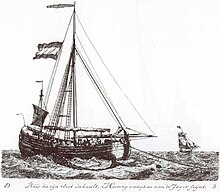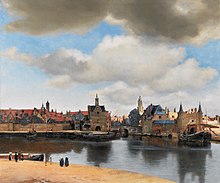Büse
The Büse (also Buse , buses , coaches , Beus , Buis , Buise , Buyse , Büyse , Buza , Bussa ; from Dutch boxwood ) was a sailing vessel , which the catch of herring in the North Sea and as a merchant ship served.
history
As early as the 12th century, rowing ships for trading trips were known as buza , bucia or bucius in the Mediterranean . However, this type of ship was probably of much earlier origin, because the name can be found in Northern Europe as early as the 11th century, where it was naturalized for Scandinavian long ships ( buza or buzur ). In the 12th century, the term was finally adopted as a type designation for a pure sailing ship. The use of this type of ship as a merchant ship is first documented in 1303 for a ship from Wismar . In the 14th and 15th centuries the Büse was further developed in Holland. In addition to its use as a merchant or war ship, the Büse achieved its greatest importance as a fishing ship. Büsen was still fishing for herring from Vlaardingen and Emden in the 18th and 19th centuries , before the Büse was replaced by the logger in the 19th century . The last Heringbuis was out of service in 1866.
The Dutch herringbuis of the early modern period usually ran in large fleets of several hundred ships, often accompanied by warships, three to four times a year during the herring season. In June and July off the coast of Northern Scotland , the Orkney and Shetland Islands , in August off the coast between Dunbar and Yorkshire and from September to November off the East Anglias . The ships often stayed at sea for weeks. The catch, which was already pickled on board , was loaded onto so-called ventjagers (seen in the background in the picture above) and transported to the home ports. Outside the herring season, the ships served as trading ships.
The Büse and the Huker and Fleuten , built according to similar design features, mark the rise of Holland to the center of fishing and merchant shipping in Europe, which in the early modern period dominated herring , whale and cod fishing in north-western Europe and the Baltic Sea trade . This shipping technology innovation also played a major role in supplying the expanding European population of the 16th century with the “poor man's meat”.
description
Was understood Büse a complete keel boat with Rundgatt and steep Steven , with a displacement between 60 and 100 tons. The rigging usually consisted of square sails on the main mast and gaffs on the small mizzenmast (also driver mast ), as well as a long bowsprit with jib boom and up to three headsails . Only the largest guns were three-masters. Except for the mizzen, most of the masts could be lowered when the driftnet was cast. The Büse distinguished itself from a. due to its remarkable ratio of length to width (initially 2.5: 1, at the end of the 16th century even 4.5: 1). It allowed high seaworthiness, maneuverability and speed, a large cargo hold and, as a fishing ship, the use of large driftnets . Equally important is the great was top surface , which is a curing allowed the otherwise in one or two days corrupting catch already on board. The Dutch bush was able to stay longer at sea and, above all, move further away from the coast in order to take full advantage of the herring fishing season around the British Isles .
See also
Individual evidence
- ↑ Hansen, Clas Broder; Knuth, Peter: Lexicon of the sailing ship types. Graefelfing (Urbes) 1987, p. 23
- ↑ Vries, J. de; Woude, A. van der: The First Modern Economy. Success, Failure, and Perseverance of the Dutch Economy, 1500-1815. Cambridge 1997, pp. 244f
- ↑ Michell, AR: The European Fisheries in Early Modern History. In: Rich, EE; Wilson, CH (ed.): Cambridge Economic History of Europe, Vol. 5. The Economic Organization of Early Modern Europe. Cambridge 1977, p. 139
literature
- Büse. In: Dudszus, Alfred; Köpcke, Alfred: The big book of ship types. Ships, boats, rafts under oars and sails, steamers, motor ships, marine technology. Augsburg 1995.
- Hansen, Clas Broder; Knuth, Peter: Lexicon of the sailing ship types. Graefelfing (Urbes) 1987, ISBN 3-924896-10-0
- Michell, AR: The European Fisheries in Early Modern History. In: Rich, EE; Wilson, CH (ed.): Cambridge Economic History of Europe, Vol. 5. The Economic Organization of Early Modern Europe. Cambridge 1977.
- Unger, Richard W .: Dutch Shipbuilding Before 1800. Amsterdam 1978.
- Vries, J. de ; Woude, A. van der: The First Modern Economy. Success, Failure, and Perseverance of the Dutch Economy, 1500-1815. Cambridge 1997.
Web links
- Historical shipbuilding working group - model of the Heringbüse Harmonie von Emden

